| Golf
Version 3.2
The Next Generation
Winter
2005
|
One
bad morning at a rally can certainly change things...
When we found this
Golf - dubbed Version 3.2 - the plan was to build it into a purpose-built
Improved Touring car, with a variety of improvements over Project GTI,
intended to maximize on-track performance at the cost of being able to
use it for rallies, hillclimbs, and other events that require a street-licensed
car.
Well, our roll on
the first Sunday stage of Rally Tennessee put paid to that idea, so Version
3.2 will instead be an improved version of the multi-purpose concept introduced
by Project GTI.
>>
Safety
- the Competition
Cages roll cage will be constructed of smaller diameter steel tubing,
to maximize weight and stiffness of the structure, based on Improved
Touring rules. It will feature additional triangulation, as compared
to the cage in Project GTI.
>>
Engine
- since v.3.2 is an earlier OBD1 Golf, the engine includes the desirable
forged crankshaft and piston oil squirters. We were originally planning
an IT-spec rebuild of the 129,000 mile lump in Project GTI but will
instead build up the new one. The engine management system on the OBD1
cars is easier to maximize as well, and will be developed as part of
our ongoing collaboration with Bildon
Motorsport.
>>
Suspension
- from the outset, the suspension will be more race-optimized than that
in Project GTI, with solid bushings replacing rubber - using more MkIII
development pieces from 247-parts.com
- plus adjustable strut top mounts, revised rear anti-roll bars, and
stouter Koni racing
struts to accommodate higher spring rates.
>>
And
more - Version
3.2 is being constructed as an "additive" racing car, whereby
we are taking it down to the bare shell and putting back only the parts
required by the IT rules. Project GTI was a "subtractive"
construction - where bits were removed piece-meal, without truly working
to make the entire package as light as possible.
|
| This
is the basis for v.3.2 - a straight, 1994, 2-door, Golf III. It came without
many of the extras included on the original Project GTI - air conditioning,
sunroof, central locking, and antilock brakes. It does have rear disc
brakes, however.
The only notable problems
include sun-broiled paint and a hood that seems to have come up at speed
somewhere in its life (not big deals in the grand scheme of race car building),
a dog-stink interior (that will be gone in short order anyway), and bad
syncros in the gearbox - which would be rebuilt regardless. It started
right up once the battery was charged, and runs like a champ.
All told, not a bad
deal for $378. The car was abandoned at Greensboro, NC European car specialists
Foreign Accents.
We purchased it from the owner, who had since moved back to the Northeast,
for the amount owed to the shop plus $250. |
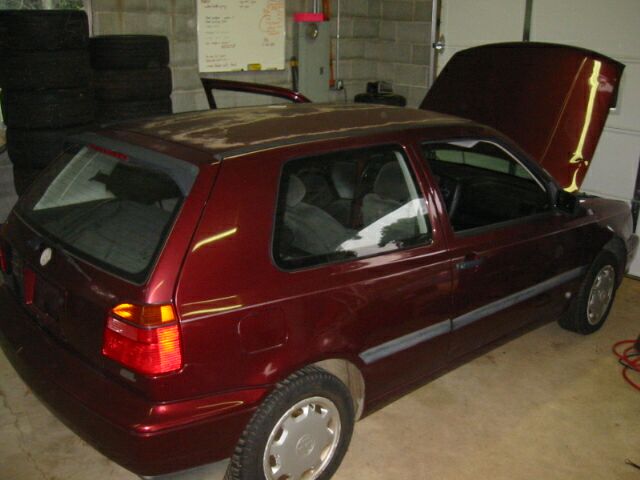 |
| For
comparison purposes, this is the interior at 9:00AM on the Saturday set
aside to prepare v.3.2 for the first major work required to turn it into
a racing car - installation of the roll cage by Competition
Cages in Hillsborough, NC. |
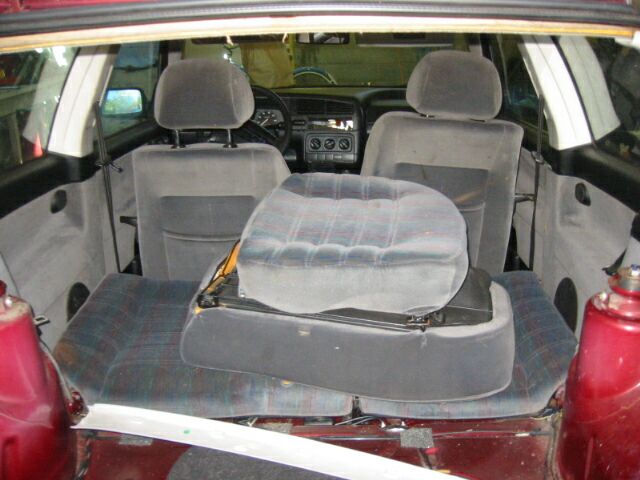 |
Here
is the same space just 8 hours later, down to the sheetmetal. Race preparation
forensics is an imprecise science but the glass particles inside the dashboard,
rusted support brackets in the dash, and a small amount of rust in the
floor - around a dent that looks like this Golf has already had a little
"off" in its life - suggest that the windshield may have been
the victim of vandalism at some point.
The driver's door
shows clear evidence of having been forced with a crowbar, next to the
latch - a common theft strategy applied to VWs.
Generally though,
the shell is in great shape and is now several hundred pounds lighter
than it was, although a few items were left in place - heater core and
fan box, steering column, and pedal cluster - to facilitate fitting of
roll cage elements. |
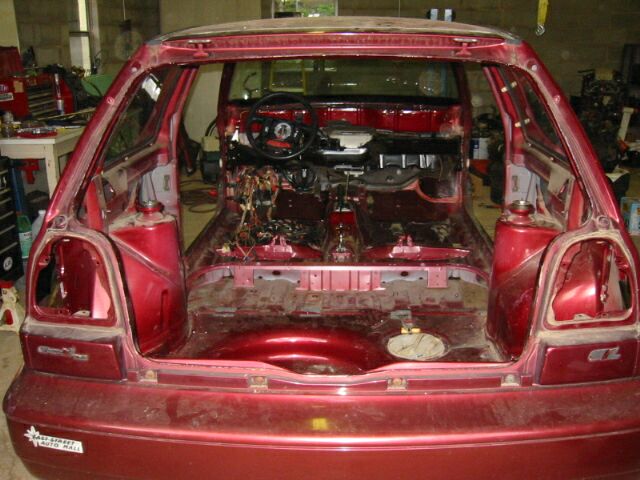 |
The
engine compartment received the same aggressive treatment. The engine
and transmission were pulled - a job made easier by the complete removal
of the bumper, grill, radiator and cross members.
The entire wiring
system was removed by strategically unfastening connectors, leaving it
in four major sections and a couple of smaller looms. It will be tidied
up before being reinstalled.
The lower radiator
support was found to have been damaged at some point, and was badly rusted.
It went into the growing trash pile and will be replaced.
At this point, only
the front and rear suspension, the front subframe, and the brake system
will remain - just enough to allow the car to be easily transported and
rolled around the shop at Competition Cages. |
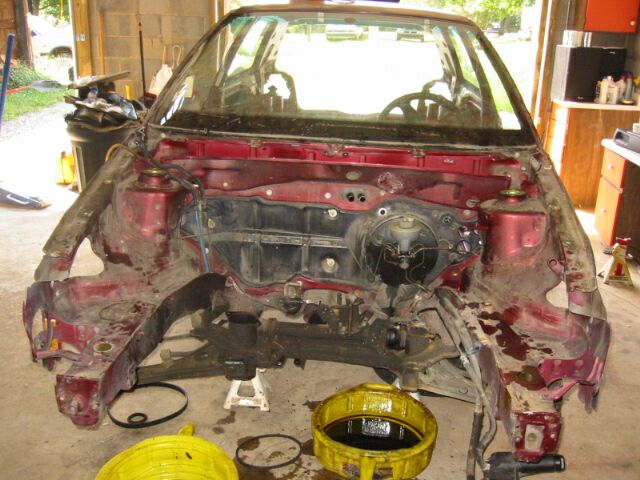 |
Even
with the parts we left on still installed, the shell is light enough that
two healthy people can pick up either the front or back end.
In this picture, chief
wrench Cameron Conover (foreground) is busy shoving it around in front
of the shop, as we prepare to load it on the trailer for the run to Competition
Cages in Hillsborough, NC.
Temporary spares make
great storage wheels, by the way. Very low drag so they are easy to push
around.
We did discover one
little surprise - and not the good kind, either: The rusted floor is bad
enough that it's going to require a little metal work before painting
begins. However, on the plus side (for those keeping score) we recouped
$90 of the original $378 purchase price by selling the early style, clip-on
side moldings, which are much in demand by the Golf street car modification
crowd. |
 |
Cage
construction has started, with main elements bent from 1.5x.095"
steel DOM tubing. Secondary optional bars are made of thinner-wall tubing
(.065" wall thickness) to save some weight by taking advantage of
SCCA's new rules.
The design is an evolution
of that used in Project GTI, and it's interesting to note how much thinner
the 1.5" diameter tubing looks, than did the 1.75" material
required for the heavier Showroom Stock version of the Golf. |
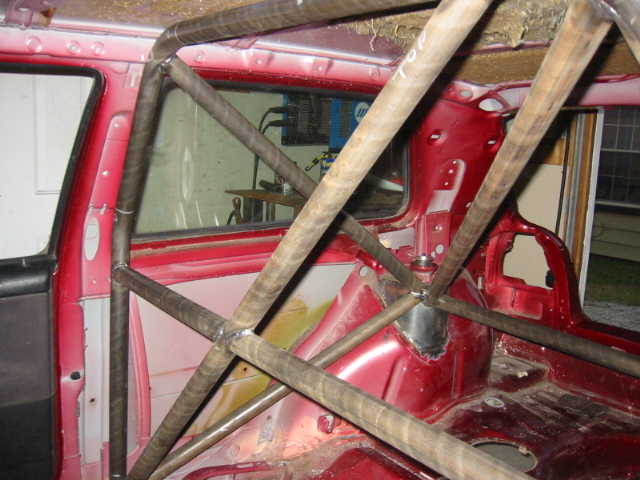 |
It
is desirable to get the cage as close to the body as possible, to preserve
the shell in the event of an impact. The main hoop actually touches the
sides of the roof line at its upper corners.
The revised door bar
design makes it necessary to move the main hoop forward almost 2 inches,
and dictates that its legs run vertically rather than bowing outward at
the level of the crosswise "harness" bar. Without these allowances,
the door bars would require a recurve - or "S" bend - to connect
to the main hoop, decreasing their strength. |
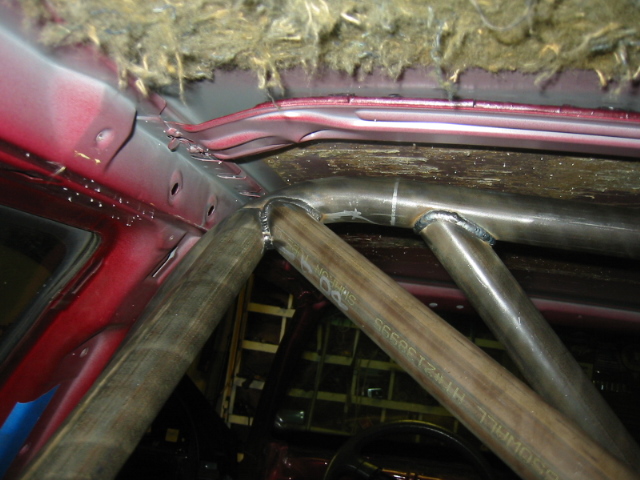 |
Beefy
plates were welded to the rear strut towers, to provide a solid base for
attaching the required rear supports, and the optional cross bar and diagonals
to the bottom of the main hoop legs - the latter an addition over the
last car.
To provide maximum
strength, tubing joints should be designed such that the centerline of
tubes intersect, as is the case with this junction. |
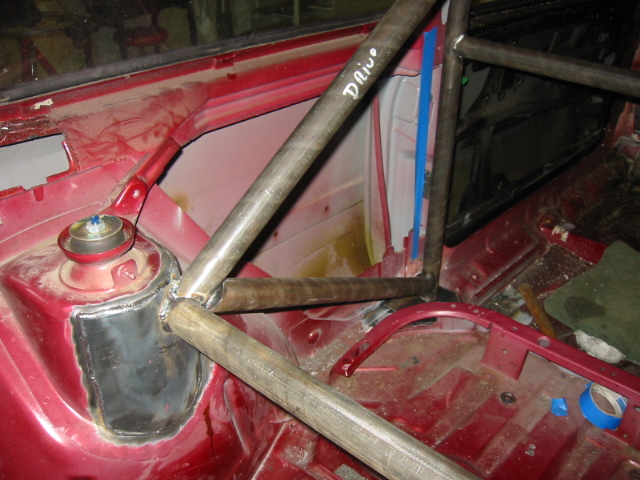 |
The
main cage legs will stand on fabricated box structures, that spread the
load over a greater area and provide more weld surface. They can also
be knocked out during construction, to allow the cage to be lowered to
complete the welds on the top of the upper tubes, where they end up very
close to the roof.
Minor rust damage
was discovered in several spots in the floor, which required clean-up
and the installation of welded patches. |
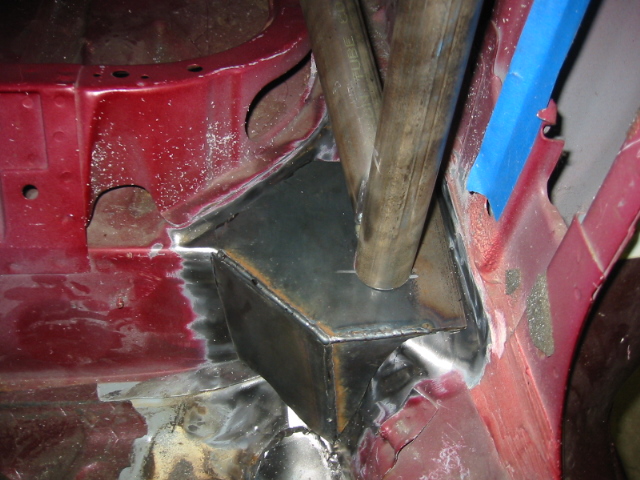 |
The
door bar structure is a logical extension of what we learned from the
original Project GTI installation.
New rules dictate
"two door bars," so to be sure the new design complies, bars
were "siamesed" rather than "X-ed." The formed steel
"taco" gussets, visible in the thumbnail below, have not yet
been installed in the larger picture on the left.
The bars also project
into the door panel area where they meet, providing more driver room without
sacrificing the crushable structure in the door itself. This feature,
combined with the smaller diameter tubing used in this structure, combine
to allow the critical bar down from the top of the windshield pillar to
run higher without interfering with the driver's hand.
Click thumbnail image
to enlarge.

The original Project
GTI cage installation |
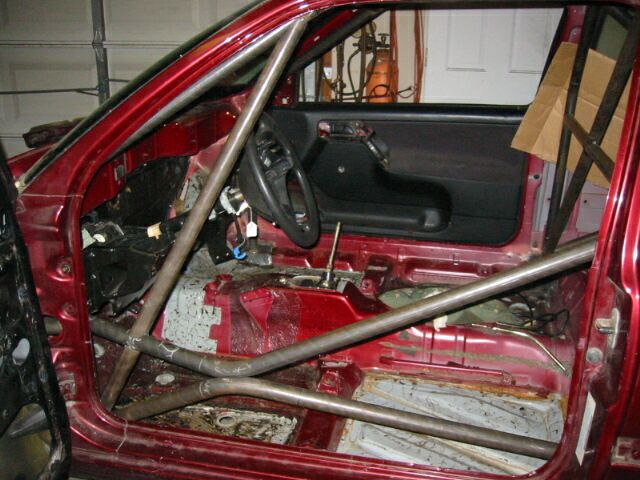 |
The
forward mounting point of the new cage is several inches farther forward,
compared to where the last one mounted. This increases the "footprint"
area of the structure, which should theoretically increase the stiffness
of the chassis.
This design uses a
pair of tubes that run from the main hoop, over the door and down the
A-pillars and joined by a cross piece over the windshield. The previous
one used a "halo" bar, connecting individual A-pillar uprights
- a decision made necessary by the fact that the car was not completely
stripped, as has been done here.
Again, the cage elements
are fitted closely to the body shell - to the point that they actually
touch in several places.
Chris Schimmel of
Competition Cages (Hillsborough, NC) will put the final touches on the
cage installation, build a mount for the Recaro seat, and work will start
in earnest on preparing for paint - repairing rust spots in the floor,
stripping undercoating, and priming the cage tubes. |
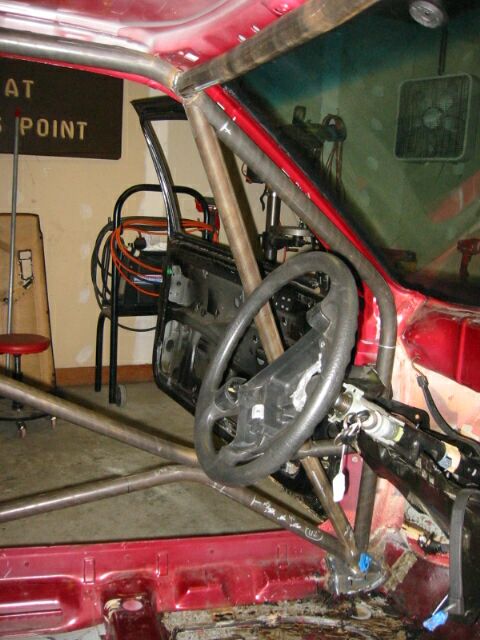 |
The
rollcage is completed, with .080" folded, "taco" gussets
added to the door bars to complete the structure. Made of .080" thick
sheet, these elements add significantly to the strength of the system.
It's hard to tell
from the pictures but the door bars actually protrude into the door panels,
in a pyramidal structure. This increases their resistance to intrusion
as well.
Also difficult to
see from the side view is how much more room there seems to be in the
cockpit with the new cage, over the original Project GTI installation
- a function of smaller diameter tubing, a tighter fit to the roof of
the car, and a seat mount that is another inch lower than the previous
design.
The cage also features
an additional diagonal alongside the driver's head, and duplicated on
the passenger side. The Recaro race seat in Version 3.2 utilizes lateral
head restraints, that will keep the driver's noggin from coming in contact
with these reinforcements. |
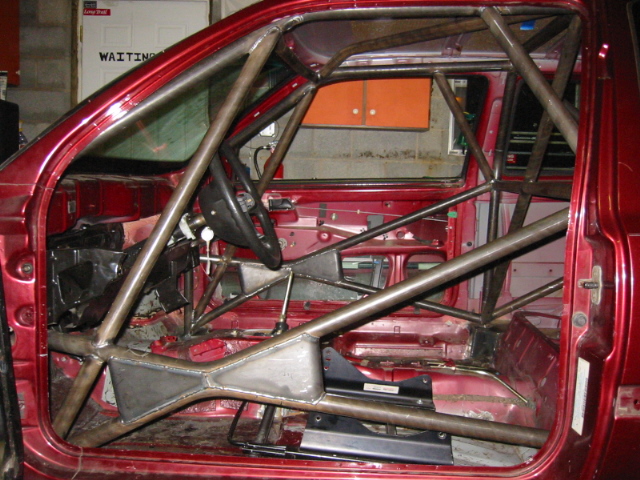 |
The
entire cage is built of seamless drawn over mandrel (DOM) steel tubing,
and conforms to SCCA and NASA technical specifications.
Visible here is the
insulating lint in the ceiling of the Golf - just part of the large amount
of useless sound- and weather-proofing that will be removed in the coming
weeks.
Calculations
indicate that the new rollcage includes 13 feet more tubing that the one
it replaces but weighs only 6 pounds more - 109 pounds, not counting gussets
and mounting plates in both designs. Approximately 9 pounds were saved
using the thinner-wall tubing in optional diagonals. |
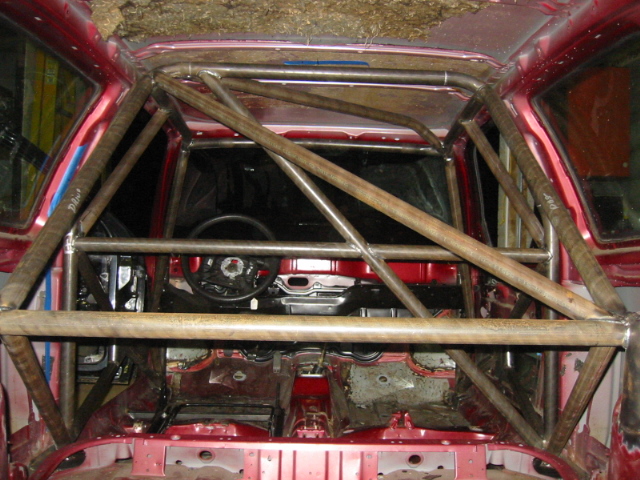 |
Progress
on v.3.2 has been slowed dramatically by the discovery of significant
rust in the floorboards, particularly on the passenger side.
It was decided that
it would be silly to build a new car around a patched-together bodyshell
so old floor sheetmetal was completely removed, by grinding off the spot
welds that secured it to the other body pieces.
The long finger of
steel structure that protrudes over the hole where the floor used to be
is the subframe mount. Luckily, it was in good shape. |
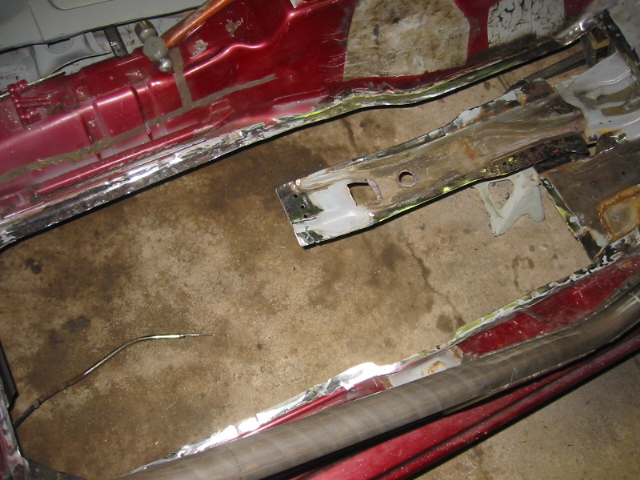 |
Factory-replacement
sheetmetal was trimmed to fit the hole resulting after corroded metal
was removed.
The lateral structure
on which the passenger seat would mount was also replaced with a new piece
- far easier than trying to remove the old one in a way that would leave
it undamaged for reinstallation. |
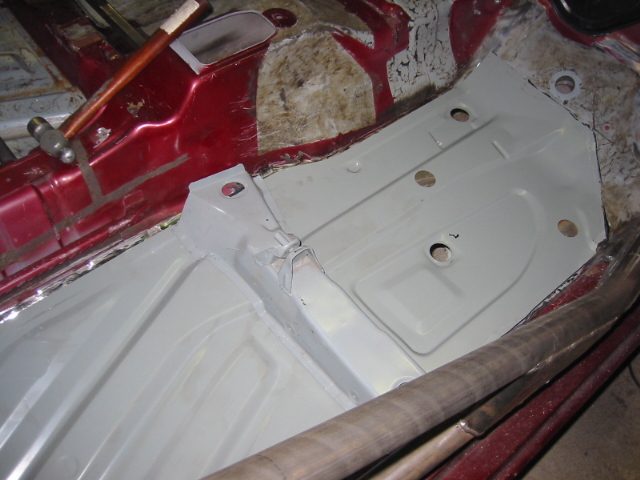 |
Kids
- don't try this at home.
To simplify the final
floor repairs and undercoating removal, v.3.2 was hoisted to a 42°
angle with a heavy duty cherry picker lift, and secured with a 2000# tow
strap to the shop rafters.
As it turns out however,
even though it was precarious looking, it was overkill because the nearly
ready bodyshell, with windshield and quarter windows installed, only weighs
approximately 480 pounds. After lowering it back to terra firma, three
people could easily lift each end onto jackstands. |
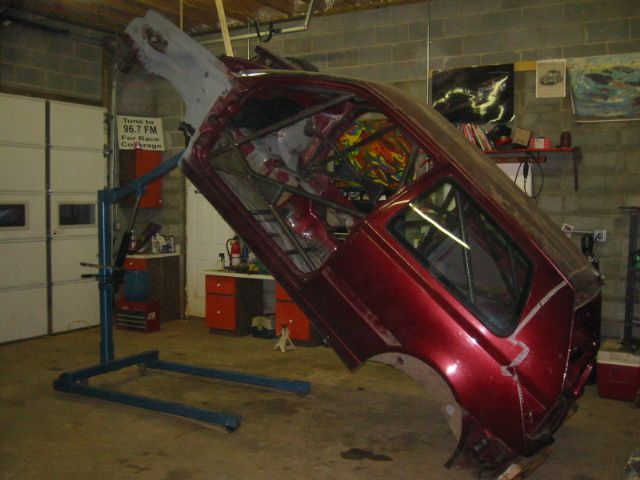 |
The
last significant repair before final body and paint work was repairing
rust damage in the front strut towers.
Here Cameron Conover
tacks in a piece of formed sheetmetal to replace a section cut out where
two stock pieces were originally joined with spot welds.
The Improved Touring
rules stipulate that repairs such as this not result in reinforcement
beyond that found in the original chassis, so it is necessary to resist
the temptation to go crazy with the MIG torch. |
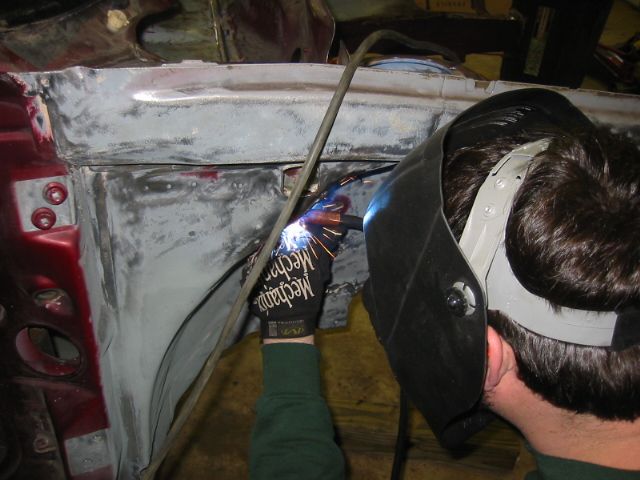 |
The
completed bodyshell is back from the painter and looks great in its VW
Jazz Blue Pearl color/clearcoat, shot by Tom
Landock of Winston-Salem, NC.
Click thumbnail images
to enlarge.


|
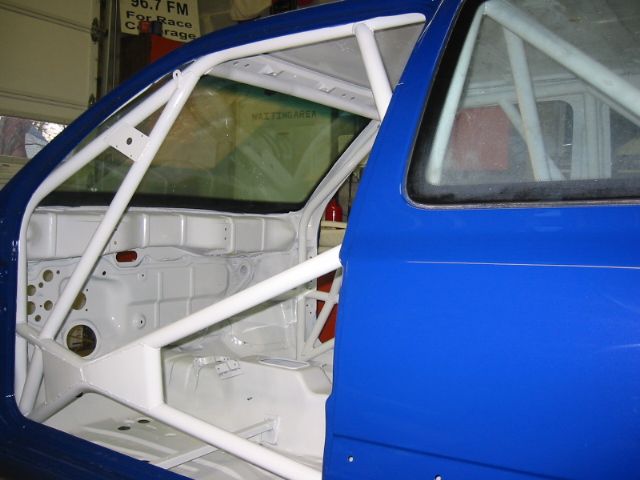 |
Days
have been spent sorting, checking, cleaning, and rewrapping the wiring
harnesses - all 25 pounds of them - prior to installation. A couple of
minor issues were identified and resolve, including some potential shorts
due to damaged insulation and a very dodgy repair.
Luckily, the body
used for the v.3.2 rebuild started life without any options, so the wiring
is far less complicated than that on the original Project GTI. |
 |
Working
out wire connections and placement in the dashboard area is a project
best taken slowly, to make the package as easy as possible to service
and to avoid the potential for damaged wires due to contact with edges,
moving parts, or high temperatures.
The fully functional
heater box, without the air conditioning option, is a tidy installation,
and the pedal cluster and steering shaft out of the first Golf - already
modified for racing purposes - have been carried over in the new car. |
 |
Though
built of all stock parts, the engine in v.3.2 has been carefully optimized
to the SCCA Improved Touring rules, with a slight increase in compression
ratio, balanced internals, light alloy pulleys, cast aluminum oil pan,
and a few other tricks intended to make a little extra power.
The new powerplant
uses OBD-I injection,
rather than the later, more sophisticated OBD-II system in the old car.
It was also necessary to offset the cam pulley slightly, to put the valve
train timing back to its stock relationship with the crankshaft position,
after decking the block.
One part we are excited
to learn more about is the PowerGasket Plus by NewSouth
Performance. The manufacturer's testing indicates lower intake air
temperatures, resulting from the decreased transfer of heat from the head
to the intake casting. We plan on doing some independent testing to assess
the effectiveness of this piece, made of a trick looking composite material.
|
 |
The
Conover engine and gearbox are in, as are most of the other underhood
parts. Fenders are mounted and the front lower cross members are in.
Next steps here include
installation of a new radiator, upper cross member, headlights, grill,
and bumper components.
It was decided to
wait on completion of the dashboard assembly until after the engine has
been run, in case it is necessary to troubleshoot the wiring harnesses
or their installation. |
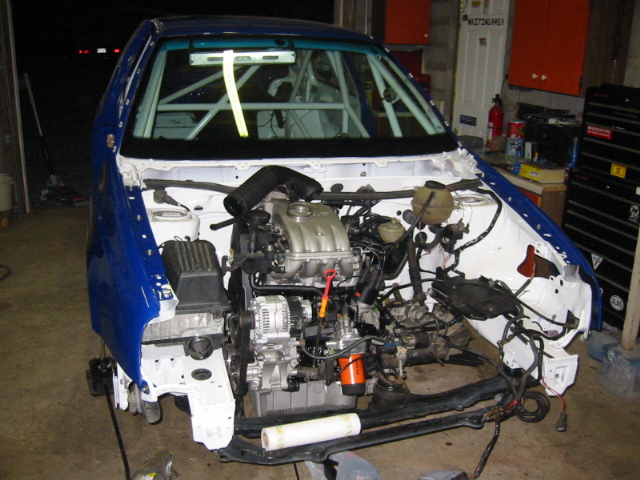 |
Out
back, the fuel tank and plumbing has been reinstalled, as have the hatch,
rear wiring, tail lights, and rear bumper parts.
A unique rear anti-roll
bar system has been designed and will be assembled onto the rear axle
beam, before bolting up the KONI
struts. |
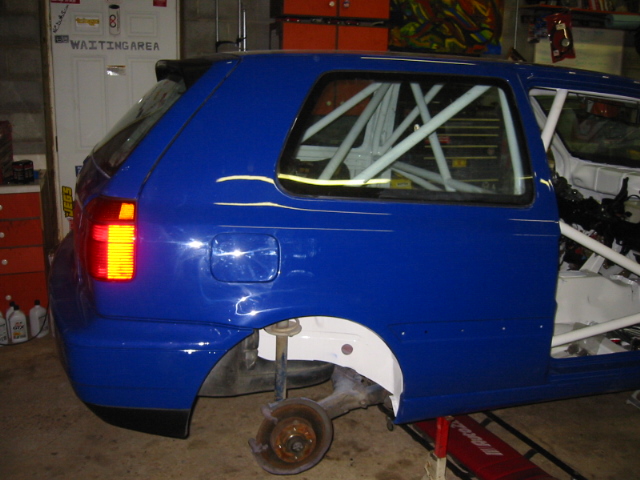 |
Getting
closer...
Assembly goes slowly
when all of the parts going on have to be as clean as Tom Landock's VW
Jazz Blue and white paint job.
It's also pretty amazing
how many parts it takes to build a car, if they all come off of the chassis
and spend weeks in bins and boxes before getting bolted back on - shift
box, lever, rod, bushing bracket, linkages; door seals, strike plates,
hinges, and wiring bellows; a whole bundle of silliness in the hatch;
bumper girder, foam insert, air dam lips, urethane cover, four lights,
and rock screen; radiator core support, radiator, fan, and shroud assembly.
And a couple of nuts
or bolts for every, single bit.
Cameron Conover fabricated
mounts for a trick, adjustable, and very huge rear anti-roll bar. The
original Project GTI tended toward understeer, which made it comfortable
to drive but not as quick as it might have been. The new set-up will allow
a range of adjustability, including a simple disconnection to take the
rear bar out of the equation altogether, in case of rain. |
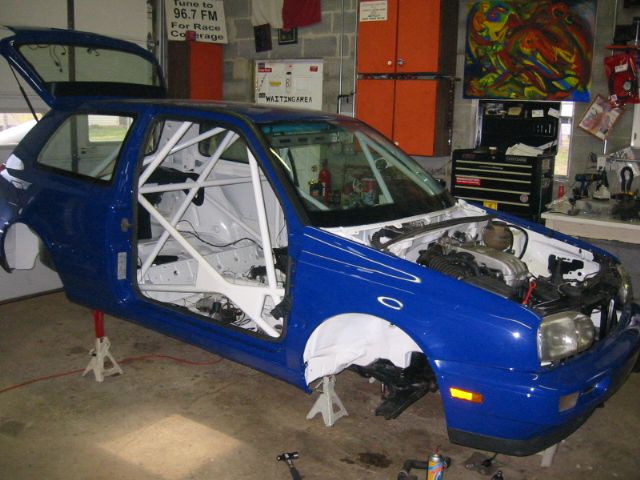 |
Another
trick detail going in during the rebuild are these all-metal bushings
in the front suspension A-arms.
From 247-PARTS.com
these parts take advantage of the new Improved Touring ruling allowing
spherical bearings as replacement bushings. It is expected that the change
will further control geometry changes in the suspension, increasing control
and grip. |
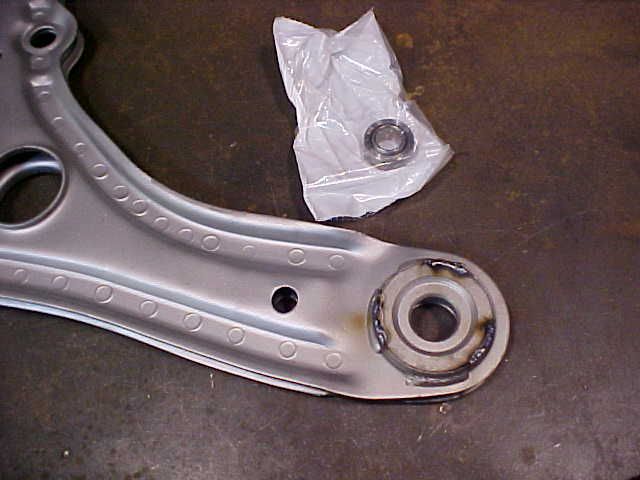 |
The
original Project GTI - nicknamed Pablo - lives on, as the grill that survived
the Rally Tennessee roll has been retained in tribute.
It will be retired
and replaced with a matching Jazz Blue piece following the new car's first
class win. |
 |
The
KONI struts were checked for
straightness and run on a shock dyno to check that they were performing
as they should.
The screw-in wheel
studs used last season have been replaced by really nice metric press-in
studs from the GM Performance Parts catalog. They have a "speed nose"
unthreaded point, to start the lug nut threads, and are of excellent quality.
The pretty white fender
wells will not be visible when v.3.2 hits the track. We run the plastic
fender liners to prevent gravel and "tire worms" from collecting
in the nooks, and to keep water from splashing into the air box when racing
in the rain. |
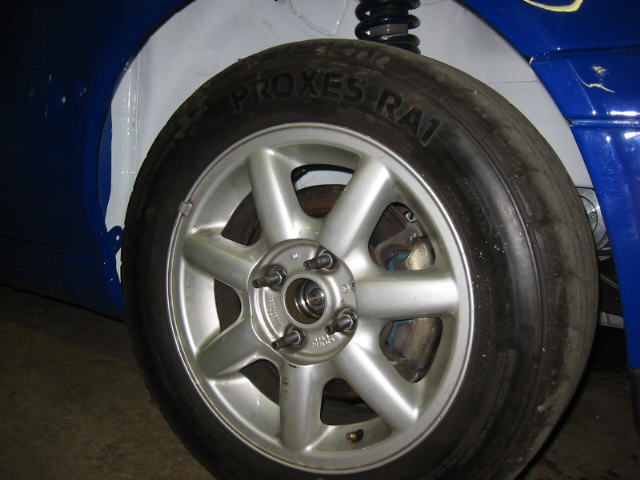 |
The
interior treatment of v.3.2 is essentially identical to the original Project
GTI - Pablo the First.
Subtle differences
include dual brake proportioning valves for the rear wheels - one per
side - replacing the single-circuit system run last season.
The required door
panels have not yet been cut and fitted around the roll cage door bars,
that protrude into the space occupied by the panels but not into the door
structure itself.
Additional gauges
are scheduled for installation, as are the DL-1 data acquisition system,
and a remote fuse block to power it and a radio for endurance events.
The RECARO seat sits
approximately 1.5" lower than last year, giving the driver additional
head room and lowering him in the chassis for better handling. |
 |
Golf
v.3.2 - Pablo the Second - is almost ready for the track.
Final details to be
completed include a competition alignment; a trip to the chassis dyno
for tuning; installation of the race harness and window net; some minor
wiring projects; application of graphics; and completion of a few details
like door handles, glass, and latches. |
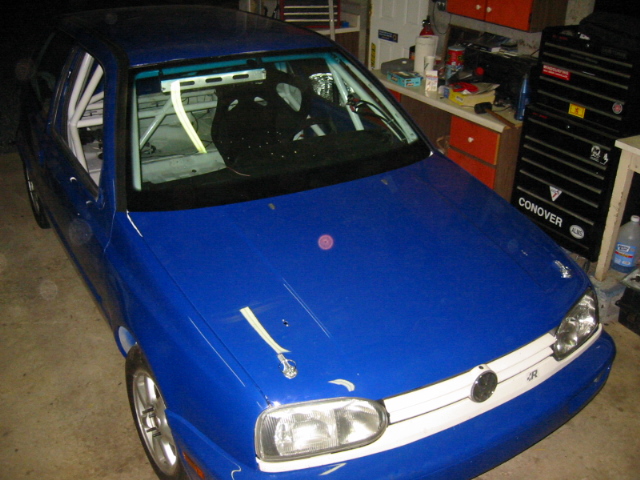 |
And
we're ready to go. Many hundreds of hours of preparation time later, a
very nice Improved Touring B car is ready for its track debut.
Next
- to the track with Golf
v.3.2. |
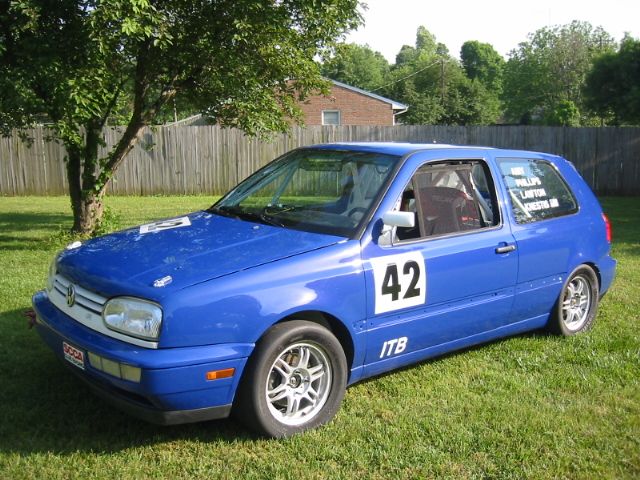 |
| Last
updated
28 November, 2008
All photos K. Knestis unless otherwise noted |
Project
GTI is headquartered in Greensboro, NC |


























